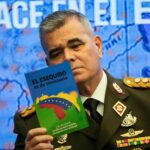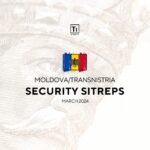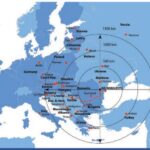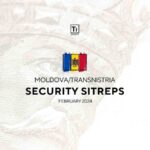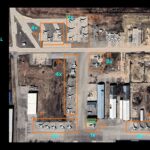Situation Report – After 3 years of ISIS occupation, Iraq’s second largest city, Mosul, has been completely liberated. The 9-months long battle saw Iraqi Security Forces (ISF) alongside allies, Shi’a PMU and the U.S.-led Coalition fighting their way block-to-block from the rigged, mined bridges of East Mosul, to the Euphrates river crossing of early 2017, liberation of the International Airport and the later fully encirclement of the remaining ISIS fighters in the Rafidyian, Sheik abu al Ula neighborhoods that form the city’s Old Town in the West.
With the city’s homecoming, inevitable strategic questions were raised in regards to the situation in Mosul, Niniveh and in whole of Iraq: Where is the state going? Can the society recover? And where to defeat ISIS next? Overall, the main questions is: What to expect next? I hope that this analysis can answer some of those questions.
Context: ISIS falls in Mosul
This was one of the largest urban battles in modern history, stretching from the ‘traditional’ urban guerrilla type of warfare to conventional, systemic tactics. Although asymmetric elements dominated the battlefront, such as the hostile informational environment perpetuated by ISIS, bomb drones or SVBIEDs, that slowed down and even halted at times the operations. I have extensively covered the tactics employed by ISIS in West Mosul in the anaylsis ‘The Day Will Come When You Won’t: Radiography of ISIS’s Desperate Tactics in Mosul’s Operational Playground’.
Between 400,000 and 1,000,000 civilians are estimated are believed to have been displaced by the battles, and lower than 400,000 to have been remained within the city. The dense urban setting used by the jihadists as fortifications and the many innocent people as human shields, made it impossible to fully contain collateral damage and minimize the destruction brought to the city itself, although in West Mosul and notably in the Old Town, few structures have remained in place, leaving just dust and rubble behind. The Governor of Niniveh said for Rudaw: “The damage in the right bank[west Mosul], compared to the left bank is 30 times more. […] I mean here the destruction of the city’s infrastructure, the houses of the people, and the government offices.” In addition, Mahdi al-Alaq, chief of staff at the Iraqi Prime Minister also told reporters that their estimates of rebuilding Mosul stands at 50$ billions.
The battle gathered around 100,000 anti-ISIS forces, stretching from Iraqi Security Forces (ISF), Kurdish Pashmerga militiamen and Shi’a Popular Mobilization Units (PMU) fighters to form an unlikely but temporary alliance in order to combat the jihadists. They suffered at least 770 casualties (some say even above 1,000) in the whole battle while combating several thousands of ISIS fighters (reports indicate around 10-12,000) which are considered to have been entirely neutralized.
This truly was one of the largest urban battles in modern history.
Damage in Mosul’s Old Town (source: AFP)
Short Retrospective:
In 2014 ISIS was on the offensive, spearheading attacks as close as Baghdad’s airport, after consolidating control in cities as Ramadi, Fallujah, Haditah and almost completely controlling the border with Syria and Jordan, while also retaining a minimal foothold on the Saudi boundary as well.
On June 9th, 2014, around 75,000 Iraqi Security Forces and Federal Police mass deserted and abandoned their posts to the jihadist offensive in Mosul, leaving over 1,000,000 people under a brutal Salafist apparatus that self-proclaimed itself as a ‘Caliphate’. From the stronghold established in Mosul, the terrorists expanded through the multi-ethnic governorate of Niniveh, shared for hundreds of years by Arabs, Kurds, Yazidis and Turkmens, Sunni and Shi’a. With Anbar province already subdued, the fall of Mosul proceeded the capture of Tikrit (capital of Salah ad-Din) and parts of Kirkuk by ISIS, moving later south-east to Diyala; gradually surrounding Baghdad.
It should be acknowledged that Shi’a militias played a decisive role in protecting the capital and the ‘urban belt’ surrounding it, when the Iraqi Army either mass-deserted from cities, or were weakened, weary to be successful enough.
Both Iraq’s capital and KRG’s (Kurdistan Regional Government) capital (Erbil) were within a comfortable reach of ‘Islamic State’s’ fighters, whilst also establishing a foothold on the Iranian border. The United States faced a dramatically degraded security environment than it left that was quickly leveraged in regional geopolitical ambitions. First came Malaki’s demise, followed by the United States led-Coalition ‘Inherent Resolve’ and Iran’s own anti-ISIS campaign that got involved to cleanse Iraq from ISIS; both powers competing to become the main backer of Baghdad’s new installed ‘compromise’ government of Abadi. While in the north, CENTCOM began exclusively coordinating with KRG’s Pashmerga militia and the Kurdish Democratic Party (KDP).
First step was to relieve pressure on Baghdad through targeted campaigns that challenged the terror organization’s consolidated postures in Ramadi and Falluajh, but also against possible sleeper cells within the capital. Due to the continued sectarian tensions and tribal politics that catalyzed the rift in 2012 in the first place stirring anti-governmental protests and anti-Shi’a sentiments, this endeavor was a challenge for the Iraqi Security Forces (ISF) as well.
Throughout 2015 and up to mid-2016, the ISF concentrated on (a) liberating the main cities of Anbar that could threaten the capital and (b) prevented the terrorist elements from keeping their ‘safe haven’ in the ‘Sunni Triangle’ (Baqubah-Ramadi-Tikrit). Aided by Shi’a militias they continued their path up north, through the multi-ethnic Niniveh region. Having the Kurdish Pashmerga already cut off the main supply route (via Sinjar) of Mosul with Raqqa in November 2015, by mid-2016, when ISFs and allies spearheaded their way to Mosul, ISIS was dramatically on the defensive not even managing to pull off counter-attacks. Therefore in late-October/ early-November ISF stormed East Mosul starting off the battle.
The United States refurbished and repaired the trashed Qayyarah West Air Base, just 60 km south of Mosul, so that air assets could be stationed there in order to provide sharp and around-the-clock air sorties. Throughout the fight, attack helicopters, drones and fighter jets have been employed by the US-led Coalition and by the Iraqi Air Force.
East Mosul was liberated by late-January 2017 so that on February-March 2017, ISF could cross the Tigris into the western banks, and managing to capture the International Airport. Within that time frame, they did not only manage to consolidate ground in the western districts, but also managed to close the last supply corridors and avenues of escape, through the countryside and suburbs of West Mosul. This encirclement came late, which also added to the slow progress registered by the ISF, only after did ISIS became increasingly entangled and asphyxiated, sheltering into the Old Town, which they transformed into ‘no man’s land’.
The Final Push for Victory
After a steadfast last push by the Iraqi Security Forces (ISF) that lasted for the past six weeks and basically crumbled their hideouts, ISIS had nowhere else to hide or flee. The remaining hundreds of fighters (200-300) have been mostly neutralized. On July 9th, 2017, ISF liberated the Old Town, and ISIS lost its last foothold in Mosul. Many fighters tried to escape by swimming through the Tigris River, but Prime-Minister Abadi assured us that his men had shot at them. He personally came by a helicopter to announce the end of the Caliphate while his soldiers planted the Iraqi flag on the western banks of the Tigris river through the dust of what only suggest was the Old Town.
Civilians and soldiers alike celebrated throughout the country, from Mosul to Ramadi, Fallujah and Baghdad. However, the most symbolic gesture was when ISIS blew up the al-Nuri mosque in an attempt to frame the Coalition for it and to disseminate propaganda. That was the exact place where on June 29th, 2014, Abu Bakr al-Baghdadi declared the formation of the ‘Caliphate’. He was filmed, at that time, showing abandoned Iraqi army badges and vehicles left by fleeing soldiers, as he added: “There is no army in the world that can withstand the soldiers of Islam,”.
Defeat and move to Tel Afar
Now, ISIS acknowledged its defeat, while also suggesting that the Turkmen-Arab town of Tel Afar is their next HQ. In accordance to this policy, their online and social media propaganda focused on the ‘irrelevance of losing land’, which I can say from an empirical perspective by identifying a significant influx of ISIS propaganda on Twitter focusing on these kind of messages.
Diagnosis:
(1) The liberation of Mosul does not guarantee peace in Mosul. For now, it is impossible to even estimate how many sleeper cells have remained in the city, posing an unpredictable and constant danger capable of taking several forms: from a trimmed and washed ex-‘mujahidin’ to an elderly woman holding a baby (recent case) or a radicalized wife of an ISIS fighter, deeming to commit attacks. The stabilization and pacification process will prove to be as difficult and tricky as the actual liberation was. In addition, the city is yet to be cleaned of mines or IED’s, which is a critical condition for the returning of refugees and internal displaced people back home, but also for the government to safely operate the reconstruction process. The population will face a housing problem, taking into consideration the level of damage inflicted throughout the whole city, a illiteracy one (being 3 years since schools have been closed) and ultimately, an economic issue; which could potentially spark a second wave of migration (internal or external).
(2) Iraq is still a fractured state with a divided society, fears and uncertainty will dominate. Iraq needs national-wide reconciliation process as its main strategic objective. As vaguely, cliché and ‘utopist’ as it sounds, that’s the only way Iraq can become ISIS-proof. Ultimately, Da’esh is simply a name, a placeholder, the ideology/ mentality is the real enemy that can shape-shift, as it did, from Al Qaeda in Iraq to ‘Islamic State of Iraq’ and later to ISIS. Such organizations emulate radical ideas as militant Salafism when they are given (unintentional) the chance to capitalize on the political-societal environment. For example (as June Cole competently points out), some of the Sunni press in Iraq has extensively focused on the damage that he ISF has done in Mosul, rather than on the victory achieved; collateral damage was the central theme for ISIS propaganda as well in the eve of Mosul’s liberation. For Baghdad, prevention and risk reduction is key, while for the Iraqis, societal resilience is the path. Easier said than done, especially since the local regional customs puts the family, the clan or tribe above the State. Subsequently, we can conceptualize the framework from a theoretical standpoint whereas the application remains under the volatile auspicious of the ‘trial and error’ methodology.
(3) There is still work to be done military-wise. The jihadists still have several strongholds in northern Iraq (Tel Afar and Hawja) and on the Euphrates River valley (al-Qa’im); the later still being directly linked with ‘safe havens’ in Syria, consolidated in Abu Kamal, Mayadin and Deir-Ezzor’s countryside. That effort will require a joint, synchronized venture with willing parties operating in Eastern Syria and Western Iraq, that even if executed by the book, still could not guarantee the prevention of a long-term ISIS insurgency around the border.
(4) Given the geopolitical value that the border area provides, it is expected that the race for the border to intensify, consequently creating additional friction between the U.S. and Iran around the Syrian Civil War and the War against ISIS in Iraq. Both external powers have already under control a border checkpoint each, the Washington backed-Rebels control al-Tanf crossing, on the Syrian side of al-Waleed, while Teheran coordinated the liberation of al-Jaris crossing, west of Sinjar which has access to the Syrian Democratic Forces (U.S. backed)-controlled Hasakha province of Syria. Let’s call it a draw, for now, but the region is gradually intensifying in this high-stakes strategic game.
(5) Northern Iraq is a heated intersection of stakeholders and their competing objectives. This could potentially errupt in the upcoming battle for Tel Afar. The Kurdish Pashmerga dreams of expanding Kurdistan Regional Government’s borders, even publicly admitting that it will not cede back to Baghdad some of the liberate villages in the area; the Shia’s militias & Iranian advisers aspire for the border while Baghdad wishes to expand and project its sovereignty throughout all of its territory. Above this entanglement comes the aspirations of secondary players, such as the Patriotic Union of Kurdistan (PUK) and its ally PKK, wishing to expand its own influence over mount Sinjar, replicating a ‘second Qandil’ (as Erdogan described it) and establishing a ‘safe haven’ stretching from north-west Iraq to its east; which inadvertently would trigger a larger Turkish involvement (Ankara is still sour over being sidelined for the battle for Mosul) via allied Kurdish factions, as Pashmerga, Turkmen or Sunni militias trained at Turkey’s camp Bashiqa in northern Iraq. Tensions have already boiled in Sinjar between the KDP Pashmerga and PUK/PKK, that were also fueled by Turkey. Also, Niniveh governorate is one of the main oil-rich territories of Iraq, therefor being a prospected region of economy, energy and commerce. This situation has the potential to play out in regards to who liberates Tel Afar and how; beyond the official narrative.
Further Prospects:
While the Islamic State’s four main wilayats in Iraq are regressing and shrinking, notably: Wilayat al-Furat (western Anbar), Wilayat al-Jazzira (north-west of Niniveh), Wilayat al-Karkuk (parts of Tamim governorate) and Wilayat Dijlah (western Tamim, around Hawija), the ISF, Pashmerga and PMU’s are expected to concentrate firstly on two main strongholds: Hawija and Tel Afar.
Hawija: a medium sized town of around 500,000 inhabitants, mostly Arab Sunnis, located in the Tamim Governorate’s plains south of the Zagros mountains, east of the Tigris river and northeast of Baghdad, is the Islamic State’s most eastern territory. Together with several rural locations south of the governorate’s capital, Kirkuk, this ISIS-held pocket is completely surrounded by ISF and Coalition forces.
Military sources from the Joint Operations Command told Al-Monitor that Hawija will be next after the fall of Mosul, but due to continued disagreements between ISF and Kurdish Pashmerga on a timelines and territory-control, the assault has been postponed several times. Similar to the whole ‘Sunni Triangle’ Hawija was both a Saddam Hussein loyalist stronghold and later an ISIS bastion, being the scene of the violent and deadly clashes between protestors and government forces in 2013. The city and its rural pockets became isolated from the rest of ISIS-held territory in mid-2016, when ISF cut-through Salah ad-Din in their way to establish a corridor from Baghdad to besiege Mosul.
The Kurds have the primary interest to push for the offensive to happen sooner than later, due to Hawija’s strategic node linking Mosul and Kirkuk and directly affecting the security in the KRG’s limits. In early 2017, Iraqi Police arrested several ISIS sleeper cells planted in the liberated city of Kirkuk and coordinated from Hawija, plotting to retake the city.
Tel Afar: Just 63 km west of Mosul and 52 km east of Sinjar, Tel Afar is another isolated pocket of the jihadists. The city itself numbers 200,000 people of Sunni Arabs but also a significant Turkmen population, or Shias. The city and its rural outskirts have been surrounded by Iraq’s 9th and 15th Divisions in partnership with Popular Mobilization Units and Katib Hezbollah for several months, awaiting the approval for an assault. The situation in Tel Afar is somewhat more complex politically as the local militants have a autonomous drive or even aspirations to succeed from ISIS, as a rumors puts it.
During the Department of Defense Press Briefing held on July 13th, attended by Colonel Ryan Dillon, Combined Joint Task Force-Operation Inherent Resolve Spokesman; Brigadier General Yahya Rasool, Spokesperson for Joint Operations Command; Brigadier General Halgwrd Hikman Ali, Spokesperson for the Peshmerga Forces, and Brigadier General Saad Maan, Iraqi Ministry Of Interior Spokesman, the Iraqi officials avoided to name the exact next target.
However, Transylvania Intelligence has reasons to believe the Tel Afar will be the focus of whatever combined or centered mission will proceed the liberation of Mosul.
End Notes:
- Iraq needs a national wide, versatile, top-to-bottom reconciliation process if it wants to survive and evolve as a prosperous nation and as a secure state.
- Building societal resilience while managing crisis from expanding are main components in order to prevent new Salafist-Jihadist shape-shifters to form from local gangs or rogue tribes.
- The outcomes of the battle for Mosul will still pose significant security problems for the inhabitants. Such issues are: ISIS sleeper cells, left-behind IED’s & mines, extreme poverty, housing problems (at least half of the city is destroyed) and a perpetual hostile informational environment.
- The surgical-military component needs to continue in order to vanquish ISIS from northern Iraq, namely from Tal Afar and Hawja but also to,
- fully degrade and annihilate the ‘safe haven’ from the Euphrates Valley acting on a transnational-operational approach that will liberate al-Qa’im (Iraq), in a joint effort with whoever clears the Syrian side of Abu Kamal, Mayadin, rural Deir-Ezzor and most importantly for now, Raqqa.
- The geopolitical race for the border, which pits the United States against Iran for a struggle to control the major border outposts and crossings, posses a significant strategic risk for the Iraq, duly because it would accentuate ethnic and political discrepancies within the society; notably if used by these external parties as local proxies.
- The strategic steak of northern Iraq raises mentionable worries over the stability of the region. ISF’s, PMU’s, Kurds and Turks have consistent motivations and plans for the Niniveh governorate, which could threaten to raise a certain alarming level of insecurity.
- Prepare for the high-possibility – high-impact hypothesis that a long-term insurgency will reinstate in Anbar (Iraq) and Deir-Ezzor (Syria) perpetuating the anarchy of the border area and that will pose a chronic threat to Baghdad.

Commander of the US-led Coalition, Joseph Dunford, and two Iraqi officers hold an ISIS flag upside down, in a symbolic gesture signaling triumph.
Founder of T-Intelligence. OSINT analyst & instructor, with experience in defense intelligence (private sector), armed conflicts, and geopolitical flashpoints.

